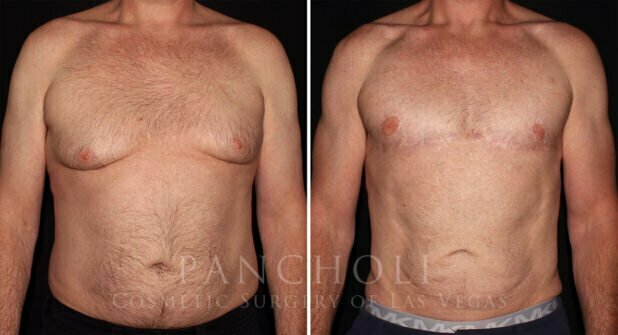Male Breast Reduction Las Vegas
If you are self-conscious about the appearance of your chest, you may be a good candidate for male breast reduction surgery. Thousands of men each year have this procedure to achieve a more masculine chest and feel more confident in their bodies. No longer embarrassed to show their chests, these men are freer to enjoy social activities and personal relationships.
- Why do I have “Man Boobs”?
- What causes gynecomastia?
- How does male breast reduction work?
- What is the recovery time for male breast reduction?
- How soon can I work out after male breast reduction surgery?
- How long does it take to see results?
- Schedule your personal consultation with Dr. Pancholi
Why do I have “Man Boobs”?
Due to various reasons, some men develop excess breast tissue and fat in the chest area. The medical term for this condition is gynecomastia, and it is thought to affect nearly half of all men in the U.S. This tissue is often first noticed during the adolescent years. Many times, it disappears after puberty. In others, it remains and may make men feel insecure and restrict themselves from removing their shirt in public.
Video transcript
“So, one of the things that we see with men is this concept of having gynecomastia, or a lot of fat, or what may seem as fat, is actually breast tissue on the chest. There are some people that have gained weight and then noticed that they have the fullness there, and that’s easy if it goes away when you diet and exercise, but you just can’t seem to do it. Liposuction can take that away. On the other hand, if you’ve noticed that you’ve gotten as lean as you’ve ever been, there’s no fat on your body, but there still seems to be this tissue there on your chest, that’s something that we actually have to go and remove. So, that surgery is a little bit different; however, they can both be treated. What you need to do depends on the extent of the amount of tissue that’s there, but just rest assured, it is something that can be corrected, and so many people have it.”–Dr. Samir Pancholi
What causes gynecomastia?
Common causes of gynecomastia include; a hormonal imbalance, drug use (e.g. marijuana, use of steroids, weight gain, and certain medications. Many men with enlarged breasts cannot pinpoint a reason for their gynecomastia.
Most men will try to “work it off” with diet and exercise. Often, this only makes the issue even more apparent. As the body fat percentage decreases, the pectoralis muscle enlarges, but glandular breast tissue remains the same.
Video transcript
“So, there are many reasons that a man may develop gynecomastia or present to us with gynecomastia. Some of it can be that you just haven’t been as fit or eating as well, and you’ve gained some weight. The other reasons can be medications or drugs. Marijuana is a very common reason for it to happen, and we’re seeing quite a bit of it now that it’s legalized in so many states. But there are other reasons that it can happen. Steroid use, if that’s happened in your life, then it’s possible that that’s the reason. Stopping it can sometimes make it go away, and other times you’ve just had some changes that need to be corrected.
Otherwise, we want to go and take a look, figure out what the source is, to see if it can be reversed. If it can’t be, then surgery can sometimes correct it, either removing the tissue or also just liposuction. At other times, it might just be genetic, and no matter what you do, this is what you have. But we can still make it better for you.”–Dr. Samir Pancholi
How does male breast reduction work?
Dr. Pancholi is experienced in multiple techniques for male breast tissue reduction surgery. He will tailor the procedure to your needs to achieve the most natural result with the least recovery time possible.
In most cases, he will use ultrasonic liposuction, direct removal of breast tissue, or a combination of both to remove the excess tissue and restore flatter, masculine chest contours. All of these procedures can be performed in an outpatient setting and require only very small incisions, which are virtually undetectable once healed.
During your initial consultation, Dr. Pancholi will determine the most appropriate course of treatment.
Liposuction + Male breast reduction
Learn more about when to combine gynecomastia surgery with liposuction in this new video from Dr. Pancholi:
Video transcript
“With gynecomastia surgery, one of the finishing touches that we like to do to really give you that polished look is to make sure we build up your upper chest. That’s really what’s going to help offset the tissue that’s been taken away and give you that workout look. One other procedure that we do is high-def liposuction. And why is that? Liposuction helps to get your abs the way that you want, to get that look down below. All of those things can be accomplished and finished off with what you’re doing in the gym.”–Dr. Samir Pancholi
- Key Benefits
- Glossary
- Improved Chest Contour: The procedure creates a flatter, firmer, and more traditionally masculine chest contour.
- Enhanced Confidence and Self-Image: Many men experience a significant boost in self-esteem and body confidence after the surgery, especially in situations where they are shirtless.
- Improved Physical Activity: Excess breast tissue can impede physical activity or make exercise uncomfortable. Reduction can enhance comfort and performance in sports and other activities.
- Minimal Scarring: Modern surgical techniques aim to minimize scarring, with incisions typically made in less noticeable areas.
- Areola: The areola is the pigmented area surrounding the nipple on the male chest, and it may be reshaped during male breast reduction surgery for aesthetic purposes.
- Aspiration: Aspiration is the process of using a cannula to suction out excess fat or tissue during male breast reduction surgery.
- Compression Garment: A compression garment is a post-surgical garment worn after male breast reduction to reduce swelling, provide support, and aid in the healing process.
- Contouring: Contouring is the process of reshaping and defining the chest area to achieve a more masculine and sculpted appearance during male breast reduction.
- General Anesthesia: General anesthesia is a state of unconsciousness induced by medications, used during male breast reduction surgery to ensure patient comfort and pain control.
- Glandular Tissue: Glandular tissue refers to the breast tissue composed of glandular cells and ducts that can contribute to gynecomastia and may need to be removed during surgery.
- Gynecomastia: Gynecomastia is a medical condition characterized by the enlargement of male breast tissue, often due to hormonal imbalances.
- Hematoma: A hematoma is a collection of blood outside of blood vessels, which can occasionally occur as a complication of male breast reduction surgery.
- Liposculpture: Liposculpture is a technique used during male breast reduction to reshape and contour the chest for a more natural and masculine appearance.
- Liposuction: Liposuction is a surgical technique used in male breast reduction to remove excess fat from the chest area through small incisions.
- Mastectomy: Mastectomy is a surgical procedure that involves the removal of breast tissue, and it can be performed as part of male breast reduction to treat severe gynecomastia.
- Nipple Repositioning: Nipple repositioning is a surgical procedure that may be performed as part of male breast reduction to achieve a more balanced and aesthetically pleasing chest contour.
- Pseudogynecomastia: Pseudogynecomastia is a condition where excess fat, rather than glandular tissue, causes breast enlargement in men. Liposuction is often effective in treating this condition.
What is the recovery time for male breast reduction?
Expect to resume normal daily activities 3-5 days after surgery. Sedentary work (a desk job) can be done as early as the next day if you feel well and Dr. Pancholi agrees it is safe; however, you should not drive yourself until you have finished taking pain medication. For the first few days after surgery, moderate discomfort associated with the ultrasonic liposuction and direct removal of breast tissue can be expected; taking pain medication as prescribed should help considerably. Minor bruising and moderate swelling is common, which can obscure your results for the first couple of weeks.
Before & After View Patient Results & Save Your Favorites >
This contains graphic images.
Click to verify you are at least 18 years of age to view all images.
How soon can I work out after male breast reduction surgery?
Physically demanding work should be delayed for at least 2 to 3 weeks or longer. The dissolving stitches are all under the skin, within 4 to 6 weeks you should be able to begin going to the gym to work out.
You should avoid exposing the scars to the sun for at least six months. Sunlight can permanently affect the skin’s pigmentation, causing the scar to turn dark. If sun exposure is unavoidable, apply broad-spectrum SPF 30 or higher at regular intervals. A good rule of thumb is that if the scars have not lost their pink color yet, the sun should be avoided.
How long does it take to see results?
Dr. Pancholi usually instructs his patients not to expect dramatic changes for the first 2 months and that the final result is not in place for up to 6 months. Wearing a compression garment for the first 2 to 3 months will help the tissues to heal in place better and minimize swelling.
References »
Taheri AR, Farahvash MR, Fathi HR, Ghanbarzadeh K, Faridniya B. The Satisfaction Rate among Patients and Surgeons after Periareolar Surgical Approach to Gynecomastia along with Liposuction. World Journal of Plastic Surgery. 2016 Sep;5(3):287-292.
Soliman AT, De Sanctis V, Yassin M. Management of Adolescent Gynecomastia: An Update. Acta Biomedica. 2017 Aug 23;88(2):204-213. doi: 10.23750/abm.v88i2.6665.
Sansone A, Romanelli F, Sansone M, Lenzi A, Di Luigi L. Gynecomastia and hormones. Endocrine. 2017 Jan;55(1):37-44. doi: 10.1007/s12020-016-0975-9.
Johnson RE, Kermott CA, Murad MH. Gynecomastia – evaluation and current treatment options. Therapeutics and Clinical Risk Management. 2011;7:145-8. doi: 10.2147/TCRM.S10181.
Don’t let gynecomastia get in the way of a body you’re proud of. At a consultation, Dr. Pancholi will listen to you and discuss all your options to get a firmer, flatter, more masculine chest. Call 702-363-0240 or contact us online using the form below.

